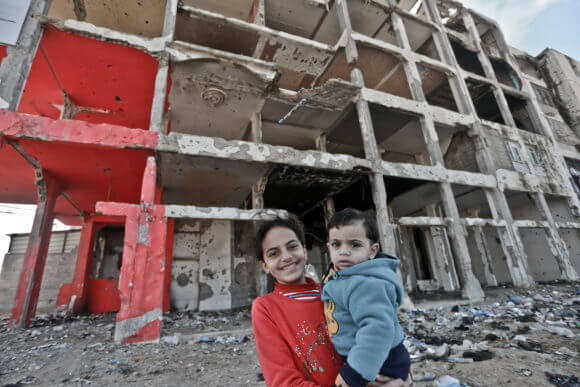Five years ago the United Nations made one of the most shocking declarations about the future of the Gaza strip, it will no longer be “a liveable place” by the year 2020. Since then a series of foreign delegations and press conferences from concerned figures have added caution to the looming and catastrophic situation.
In 2014 the Palestinian Water Authority reported 90 to 95 percent of Gaza’s water was “unfit” for consumption. That number has only increased since. The following year Oxfam found reconstruction from the 2014 war “could take more than 100 years,” as a result of Israel’s siege, which limits building materials. That same year the World Bank said, “Nearly 80 percent of Gaza’s population receives some kind of social assistance, and nearly 40 percent of them still fall below the poverty line.”
Euro-Mediterranean Human Rights Monitor further found at the start of 2016, Gazans were not coping with the devastating environment. “Fifty-five percent suffer from clinical depression,” a news release stated.
The population has no choice but to carry forward, despite the gloomy reality of life after decades of occupation, three devastating wars, and a governmental split—all of which have impending risks in the most densely populated place in the world.
Yet, when Gaza’s nearly two million residents read these newer harrowing statistics, they are not shaken by the shocking warnings. They prefer to confront the statements with impassivity. Even though their lives are directly touched by this 2020 estimation that their home will not be inhabitable, they look the other way with their day-to-day behaviors suggesting no serious concern.
In a crowded flea marketed in downtown Gaza City, Palestinians often described themselves as living in a constant state of crisis, one that began in earnest during the 2014 war. At the end of the 51-day conflict with Israel, a quarter of Gaza’s population was left food insecure, and more than 10,000 homes, 15 hospitals, and Gaza only power plant were in ruins. Reconstruction has been marginal with new materials limited, making the used items in the outdoor market all the more prized.

“The international community always states there is a crisis in Gaza and then raises alarming statements. We were afraid in the past, but today people have become more cold-hearted,” said Adnan Abu Shamala, 87, a scrap vendor in the bazaar. “I was in Amman four years ago where people were laughing loudly in every coffee shop. I met people there and I told them that I have not even smiled since six years due to the bitter life in my homeland.”
“You don’t have to make much of an effort before finding scenes of no hope,” he continued, “Just sit on any street corner in the city and watch. Then you will form a complicated concept on despair by their non-ever-smiled faces.’
“Here we do not die nor live, we live suspended as though there is no sure thing. Fear and helplessness dominate lives of these people,” Abu Shamala added, explaining he no longer stocks up on rations even though food can be scare at times.
“Storing flour, oil and sugar was a preventive measure in cases of emergencies in the past, but today, we are not going to store oil, flour and sugar as we did in the 1948 and 1967 wars,” he said.

Hani Mezaini, 38, a curtain maker with a stale in the market has a pessimistic view of the international community and aid groups mentioning his city frequently as a disaster zone. He said it’s all a game of “political calculations” intended for the ears of other officials and not to benefit the people living in Gaza.
“Throughout my life, I have not known anything except conflict, [political] factions and occupation,” Mezaini mused, “So will someone come to warn [me of an impending crisis] and persuade me to change my mind?—Nothing will be changed in Gaza as long as Israel practices its occupation.”

Holding out his cellphone Mezaini showed a picture of himself taken beside a river while he was in China a year and a half ago. He is sure he looked 10 years younger there.
“We gain 10 years every year we spend in Gaza,” Mezaini said, adding people are interested in more immediate matters than what the UN warns will happen by 2020. “Can you understand the physiological state of a nation that lives in 12 hours of each day in a blackout due to power shortages?”
“If cautions are made in advance, it will push people to immigrate and abandon Gaza for the Israelis, and so people develop their own weapon of cold-heartedness to acclimate the deteriorating conditions.” Mezaini told Mondoweiss.


Psychiatrist Jamil Tahrawi researches trauma in children in Gaza, and said that those exposed to successive crises usually shun leaders and decision-makers. In his view, Palestinians have adopted that behavior and distrust or ignore statements by the United Nations. “Gaza’s population lives in a stage of psychological extinction,” he said.
Professor of political science at Al Azhar University in Gaza, Naji Shurrab, agreed successive negative warnings about what is happening in Gaza has the detrimental effect of inspiring frustration instead of hope, “which explains the desire of thousands of young to migrate and search for their future elsewhere,” he said.
“Local community leaders and opinion makers involuntarily contribute to sounding unjustified alarm bells that deteriorates what is left of the morale among people,” Shurrab said, “but they act in good faith and seek to attract the world’s attention to this unbearable humanitarian situation.”

(Photo: Mohammed Assad)



(Photo: Mohammed Assad)


